ISSN ONLINE(2319-8753)PRINT(2347-6710)
ISSN ONLINE(2319-8753)PRINT(2347-6710)
V.R.Rathi1, Dr.C.D.Modhera2
|
| Related article at Pubmed, Scholar Google |
Visit for more related articles at International Journal of Innovative Research in Science, Engineering and Technology
The Construction Industry is a major consumer of material and energy sources of India. Among all the materials used in construction, concrete, which is the most widely used, can have a significant impact. Meanwhile, nanotechnology is one of the most influential technologies in this century and it has significantly attracted the construction sector. Better understanding and engineering cementitious material at nanometer scale can result in novel construction materials which are more strong and durable than conventional materials. Engineering concrete at the nanometer scale includes the incorporation of nano sized particles into concrete at suitable proportions and methods. The basic concept behind using nano material which are having large surface area is to improve compressive and flexural strength at early ages, improved hydration characteristics and reduced porosity and water absorption when compared with conventional cementitious materials. Nano materials can also pave the path to reduce the cement content in concrete than the conventional mixes while maintaining same strength characteristics, which will lead into the production of ‘greener’ concrete. This paper reviews the efforts, current status, and effect of various nano materials on properties of cement mortar and concrete. So that better understanding of the materials and their uses.
Keywords |
| Nano materials, Cement Paste, Cement Hydration, Mechanical Properties. |
INTRODUCTION |
| The civil constructions consumes great part of the natural resources extracted from the planet and concrete is the greatest cause of this consumption, regarded as the second most consumed material by mankind, topped by water. Reports shows that the cement production in 2002 was 1.56 GT with an average growth of 4.4% per year, but the production of in early 21st Century was 12.6 GT. These figures shows that the materials used in concrete represent twice as much as the world’s production for as the remaining construction materials. This represents the consumption of 2.2 tones per capita per year. Cement consumes 5.5 GJ of energy and liberates around one tone of CO2 per tone of clinker, considering behind the amount of raw material extracted for making concrete in the form of aggregates (course and fine) and amount of CO2 emission in atmosphere. It is the major industry responsible for global warming. So there is great interest in replacing a long time used materials in concrete structure by a new material to reach more durable concrete. It is well documented in Chemistry, Physics and Mechanics that concrete production with well designed and developed materials result in much harder and cheaper concrete of the new materials that can improve mechanical and physical properties of concrete is Nano materials. Nano material can charge the concrete world due to their properties at ultra fine level. Nanotechnology has been defined by Drexler et.al. As “The control of the structure of matter based on molecules – by molecules, control of products and by-products”. Nanotechnology can be considered as the most modern aspect in the field of science and technology. Because nanotechnology has great market potential and economic impact. |
| While the meaning of “Nanotechnology” varies from field to field and country to country as widely used as “catch all” description of anything very small, nano-technology is commonly defined as understanding, control, and restructuring of matter on the order of nano meters i.e. less than 100 nm to create materials with fundamentally new properties and functions. The properties and processes at nano scale defines the interactions that occur between particles and phases at the micro scale and the effects of working loads and the surrounding environment at the micro scale processes occurring at the nano scale ultimately affect the engineering properties and performance of the bulk materials. In contrast to other technologies, Nano-technology is much less well-defined and well-structured, Nano which comes from Greek word for dwarf, indicates billionth. One nano meter is billionth of meter that is about 1/80,000 of the diameter of human hair. Nanotechnology can best be considered as a “catch-all” description of the activities (any application of science and technology) at the nanometer scale that have application in the real world. Definitions of Nanotechnology vary, but it is generally referred to understanding the manipulations of matter on the nano scale from 0.1 nm to 100 nm. |
II HISTORICAL DEVELOPMENT OF NANO- TECHNOLOGY: |
| Nature has been manufacturing nano sized objects for billion of years, such as cell in plants and animals, but we cannot call that nanotechnology. Also nano particles can be found in Ming-dynasty pottery and stained glass windows in medieval churches. But then people were not aware of the nano particles involved, and as they have no control over particle size or knowledge of structure at the nano scale, they were not using nanotechnology as currently defined. The concept of nanotechnology was put forward theoretically in 1959, by Frynman, The Nobel Prize Winning Physicist said that nothing in the law of physics prevented us from arranging atoms the way we want. He even pointed to a development path way: Machines that would make smaller machines suitable for making yet smaller machines and so on ….. The classic “top down” approach in 1974, Taniguchi introduced the term nanotechnology to describe precision manufacture of parts with finishes and tolerances in the range of 0.1 nm to 100 nm. (Ref.Fig-1) In 1981 Drexler pointed out a new approach construction of materials and devices from the “bottom up” with every atom in designed location. Around the same time, Binnig & Rohrer at IBM invented the scanning tunneling microscope (STM) which allowed Scientist for the first time to view things (e.g. Nano particles) at atomic resolution. Soon afterwards, the atomic force microscope (AFM) for working with nano conductive materials was also developed. Since then, a raft of related instruments now known collectively as scanning problem microscope (SPM) have been developed to analyze properties of nano structure, molecules and atom on the surface. The capability to manipulate and positional control matter on nano scale was demonstrated, for the first time, in 1989 when Eigler used SPM to slowly arrange 35 xenon atoms to spell out letters IBM (spanning less than 3 nm) on top of crystal of Nickel. Over the past decade, the focus on nanotechnology has broadened beyond physics and precision engineering to include “Almost any material or device which are structured on the nano meter scale in order to perform functions or obtain characteristics which could not otherwise be achieve”. |
III LITERATURE REVIEW |
| Recently nanotechnology is being used in many applications and it has received increasing attention in building materials, with potential advantages and drawbacks being underlined. At present a significant number of R& D work dealing with use of various Nano materials like Nano silica, colloidal Nano Silica (CNS), Al2O3 TiO2, ZrO2, Fe2O3, carbon nano tubes (CNT) in cement based materials are available in the literature. The main thing is that the pozzolanic activity of the material is important in forming the C-S-H gel so that size and amount of CH crystals are significantly decreased and the early age strength of hardened cement paste is increased. Alirza Naji Givi set.al. studied the size effect of nano SiO2 particles of size 15nm and 80nm by replacement with 0-5, 1, 1.5 & 2% b.w.c. and result shows that at 1.5% gets maximum compressive strength and there after decreases, also final strength of 80nm particles is more than 15nm particles, also there is considerable improvement in flexural and split tensile strength of Nano SiO2 blended concrete. A. Sadrmotazi et.al. has studied effect of PP fiber along with nano SiO2 particles up to 7% which improves the compressive strength of cement mortar by 6.49% also PP fiber dosages beyond 0.3% decreases the compressive strength but beyond 0.3% dose of PP fiber increases the flexural strength which shows effectiveness of nano SiO2 particles. Also up to 0.5% PP fibers in mortar water absorption decreases which indicates pore refinement of nano SiO2 particles and better dispersion of fibers. Also mortar with 0.1% PP fiber shows improvement in shrinkage. . Ali Nazari, Shadi Riahi – studied the effect of Nano SiO2 particles along with 3% replacement of nano particles and 45% replacement of cement by GGBFS shows improved split tensile strength. The pore structure of SCC containing SiO2 particles is improved and content of all mega pores and macro pores is decreased. They have also studied effect of ZnO2 nano particles on SCC concrete with constant w/c ratio of 0.4 and observed that by increasing the content of super plasticizer flexural strength decreases i.e. plasticizers retards the cement hydration, ZnO2 content increased up to 4% b.w.c. increases the flexural strength of SCC. In another experimentation the same author studied effect of Al2O3 nano particles on properties of concrete and In another experimentation the same author studied effect of Al2O3 nano particles on properties of concrete and found that cement could be replaced up to 2% for improving mechanical properties of concrete, but Al2O3 decreased % water absorption of concrete; However workability of concrete was reduced so require plasticizer; by XRD analysis it is concluded that there is more rapid formation of hydrated product takes place; author also studied the effect of replacement of cement by GGBFS up to 45% b.w.c. which results in increased split tensile strength in presence of nano SiO2 particles up to 3%. Thermo gravimetric analysis shows that SiO2 nano particles could increase the weight loss of specimen when partially added to cement paste up to 3% more rapid formation of hydrated products confirmed by XRD analysis. Surya Abdul Rashid et.al. studied effect of Nano SiO2 particle on both mechanical properties (Compressive, split tensile and flexural strength) and physical properties (water permeability, workability and setting time) result shows that binary blended concrete with nano SiO2 particles up to 2% has significantly higher compressive, split tensile and flexural strength compared to normal concrete. Partial replacement of nano SiO2 particles decreases the workability and setting time of fresh concrete for samples cured in lime solution. Ali Nazari, et.al. studied strength assessment and % water absorption of SCC containing different amount of GGBFS and TiO2 nano particles and found that Portland cement can be replaced up to 45% weight of GGBSF and up to 4% weight of TiO2 nano particles and found that compressive, split tensile and flexural strength of specimen has increased considerably due to more formation of hydrated products in presence of TiO2 and also improves the water permeability resistance of hardened concrete. Author also studied effect of CuO nano particles of average particle size 15nm on SCC and observed that increased % and polycarboxylate admixture content results in decreased compression strength. The CuO content up to 4% weight compressive strength of SCC has increased, CuO nano particles up to 4% could accelerate the first peak in conduction calorimetric testing which is related to the acceleration of formation of hydrated cement products. A.H. Sekari & M.S. Razzaghi – studied effect of constant content of Nano ZrO2, Fe2O3, TiO2, and Al2O3 on the properties of concrete and observed that contribution of nano Al2O3 on improvement of mechanical properties of HPC is more than the other nano particles and All the nano particles have noticeable influence on improvement on durability properties of concrete. A.M.Said et.al. Studied effect of colloidal Nano silica on concrete incorporating class F fly ash and observed that overall performance of concrete with or without fly ash was significantly improved with addition of variable dosages of nano silica. The mixture containing 30% FA and 6% CNS improves compressive strength considerably. MIP result shows porosity and threshold pore diameter was significantly lower for mixture containing Nano silica. The RCPT test shows that passing charges and physical penetration depth significantly improved. Alireza Najigivi et.al. studied effect of Nano SiO2 particle size on water absorption of RHA blended concrete, it is concluded that cement could replaced up to 20% by RHA in presence of Nano SiO2 particle up to 2% which improves physical and mechanical properties of concrete. Ali Heidari & D. Tavakoli studied the effect of replacement of cement by ground ceramic powder from 10 to 40% b.w.c. and nano SiO2 from 0.5 to 1% replacement result shows that there is dramatic decrease in water absorption capacity and increase in compressive strength when 20% replacement is done with ground ceramic powder with 0.5 to 1% as the optimum dose of Nano SiO2 particles. Hu-Li, et.al. studied the abrasion resistance of concrete containing nano particles of TiO2 and SiO2 along with polypropylene (PP) fibers and found that abrasion resistance can be improved considerably by addition of nano particles and PP fibers also abrasion resistance of PP fiber + Nano particles is much higher than only nano particles. The abrasion resistance of nano TiO2 particles is better than nano SiO2 particles. Also relationship between abrasion resistance and compressive strength is found to be linear. J.Comiletti et.al. In this study effect of micro and nano CaCO3 addition on the early age properties of ultra high performance concrete (UHPC) cured in cold and normal field conditions were investigated. The micro CaCO3 was added from 0 to 15% b.w.c. and nano CaCO3 was added at the rate of 0. 2.5 And 5% b.w.c. Results shows that by incorporating Nano and micro CaCO3 the flow ability of UHPC is higher than the control mix which increases the cement replacement level. The mixture containing 5% nano CaCO3 and 15% micro CaCO3 gives shortest setting time at 10oC and 20oC at 20oC the highest 24 hrs compressive strength is achieved by replacing cement with 2.5 and 5% micro CaCO3 and highest compressive strength at 26 days was achieved at 0% nano and 2.5% micro CaCO3. M.Nill, A. Eshani et.al. Studied effect of micro silica and colloidal nano silica on properties of concrete and observed that concrete will attain maximum compressive strength when it contains 6% micro silica and 1.5% nano silica. The highest electrical resistivity of concrete was observed at 7.5% micro and nano silica. The capillary absorption rate is lowest at 3% micro silica and 1.5% nano silica. M. Collepardi et.al. Studied ternary combination of silica fume, fly ash and ultrafine amorphous colloidal silica (UFACS), result shows that steam cured concrete containing SF and FA alone are much stronger than NC cured at room temperature at early age where as compressive strength at 28-90 days of steam cured concrete is less than NC cured at room temperature. So author advised to use SF,F.A&UFACS for the manufacturing of precast unit. Min. Hongzhong et.al. Studied effect of NS & high volume slag mortar on setting time and early strength and observed that rate of hydration is increases with addition of NS, compressive strength of slag mortar increases with increase in NS dosages from 0.5 to 2% by weight of cement. 2% NS reduces initial and final setting time and compressive strength increases by 22% and 18% at 3 days and 7 days with addition of 50% slag. NS with particle size 7 & 12 nm are more effective in increasing cement hydration and reaction compared with silica fume. |
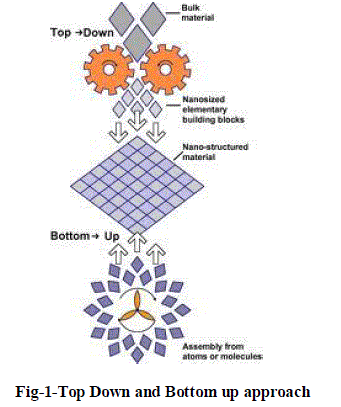 |
IV RESEARCH INITIATIVE |
| By taking advantages of nano structured characterization tools and materials the optimum use of nano silica in powder form or colloidal nano silica will create a new concrete mixture that will result in durable concrete. Generally concrete is two phase system with cement paste and aggregate, but the aggregates are inert in nature. The hydrated cement paste is composed of capillary pores and hydration product i.e. gel pores, C-S-H, CH, Aft (Ettringite), AFm (mono sulphate) etc. and one third of pore space is comprised of gel pores and the rest are capillary pores. There are various indications that confirms the layers nature of C-S-H study conducted by Feldman and Sereda indicates that the cement paste inflow increases as water is removed until a point, at which the flow decreases, this point is the indication of a possible collapse in the nano structure of hydration products and the C-S-H that is produced during the hydration of Portland cement has the micro structure as shown in fig. 2. |
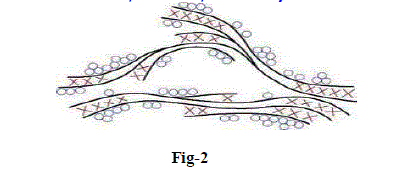 |
| Feldman-Sereda Model of Microstructure of C-S-H Black Lines- C-S-H Sheets. Circles-Absorbed water Crosses-Interlayer Water |
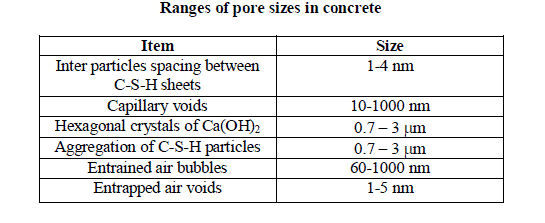 |
V CONCLUSIONS |
| After reviewing the literature. I came to know about nanotechnology and its use in concrete. It has the great potential to improve the performance of concrete. The study leads me to following conclusions. |
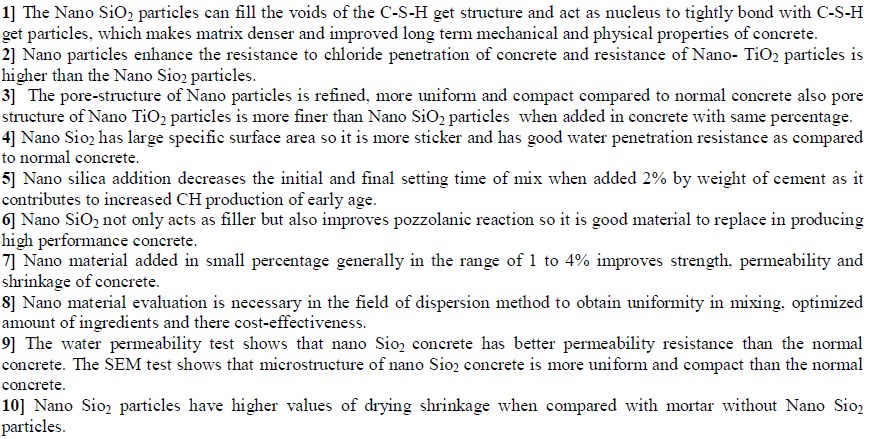 |
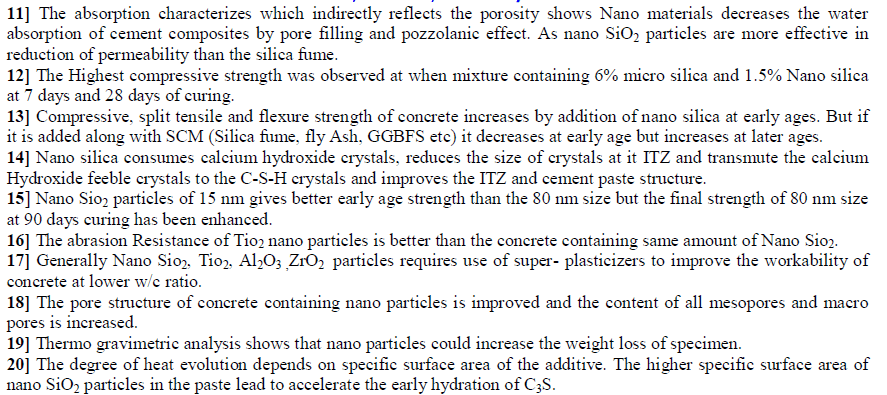 |
References |
|